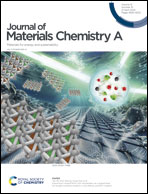Pyridine-induced caused structural reconfiguration forming ultrathin 2D metal–organic frameworks for the oxygen evolution reaction†
Abstract
Two-dimensional metal–organic frameworks (2D MOFs) as an ideal prototype material for the electrocatalytic oxygen evolution reaction (OER) can expose more metal active sites due to their ultrathin 2D structure. Herein, a two-dimensional Co3BDC6Py3DMF1 (termed Co MOF-Py3, BDC = 1,4-benzene dicarboxylic acid, Py = pyridine, and DMF = N,N-dimethylformamide) catalyst was prepared by a solvothermal bottom-up method by introducing pyridine to replace the triethylenediamine organic coordination in three-dimensional (3D) Co2(BDC)2(DABCO)·4DMF·H2O (termed Co MOF, DABCO = 1,4-diazabicyclo[2.2.2]octane). Compared to the 3D columnar Co MOF, the overpotential of ultrathin 2D nanosheet Co MOF-Py3 at 10 mA cm−2 decreased by 55 mV to 307 mV, and the Tafel slope was 52.14 mV dec−1. To further improve the catalytic capability of Co MOF-Py3, the Fe element was introduced into Co MOF-Py3 by impregnation to obtain a Co3Fe1 MOF-Py3 catalyst, which exhibited excellent OER performance with a low overpotential of 269 mV at 10 mA cm−2 and a small Tafel slope of 45.29 mV dec−1. Structural characterization reveals that the addition of a specific quantity of pyridine could completely replace the triethylenediamine ligands, thus leading to structural reconfiguration of the entire MOF, resulting in a structural alteration from 3D to 2D and enhancing the number of metal active sites to catalyze the OER.


 Please wait while we load your content...
Please wait while we load your content...